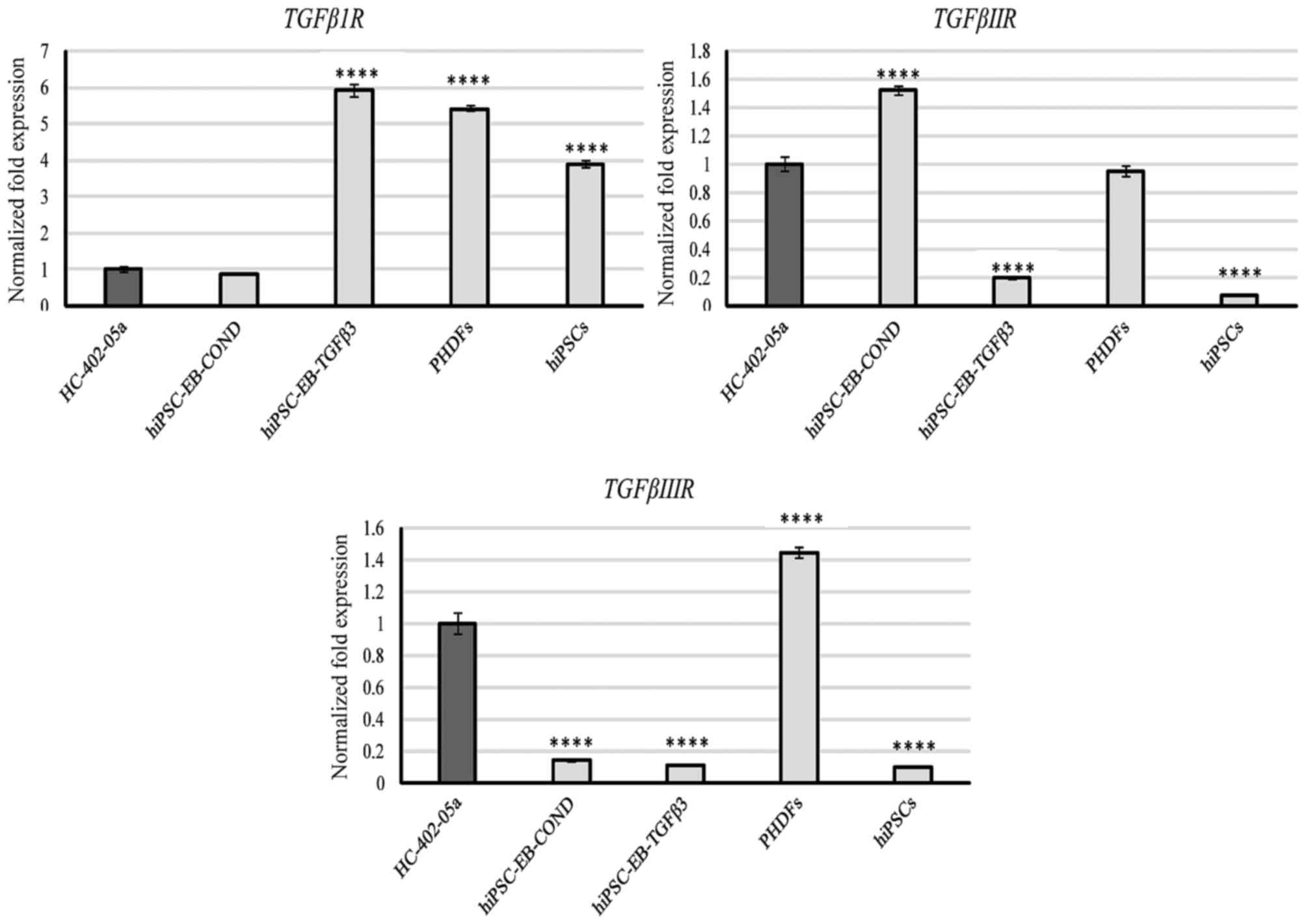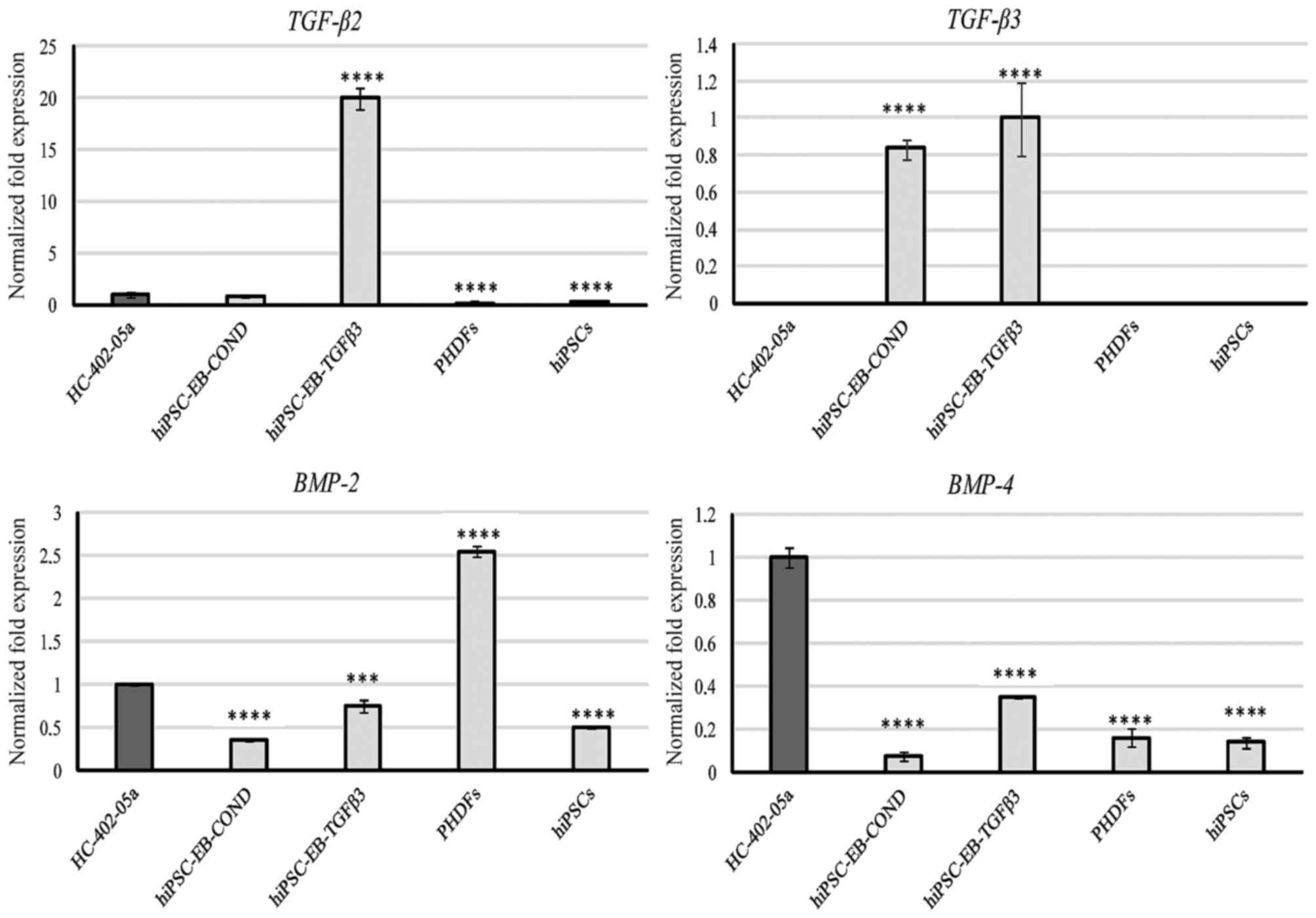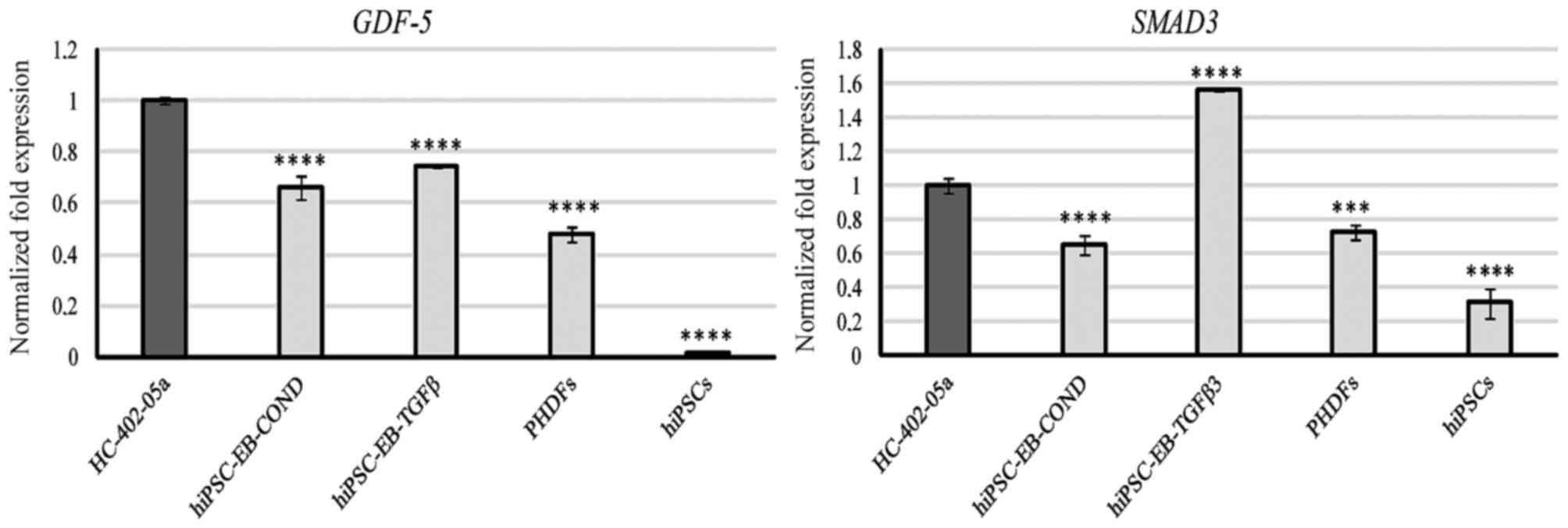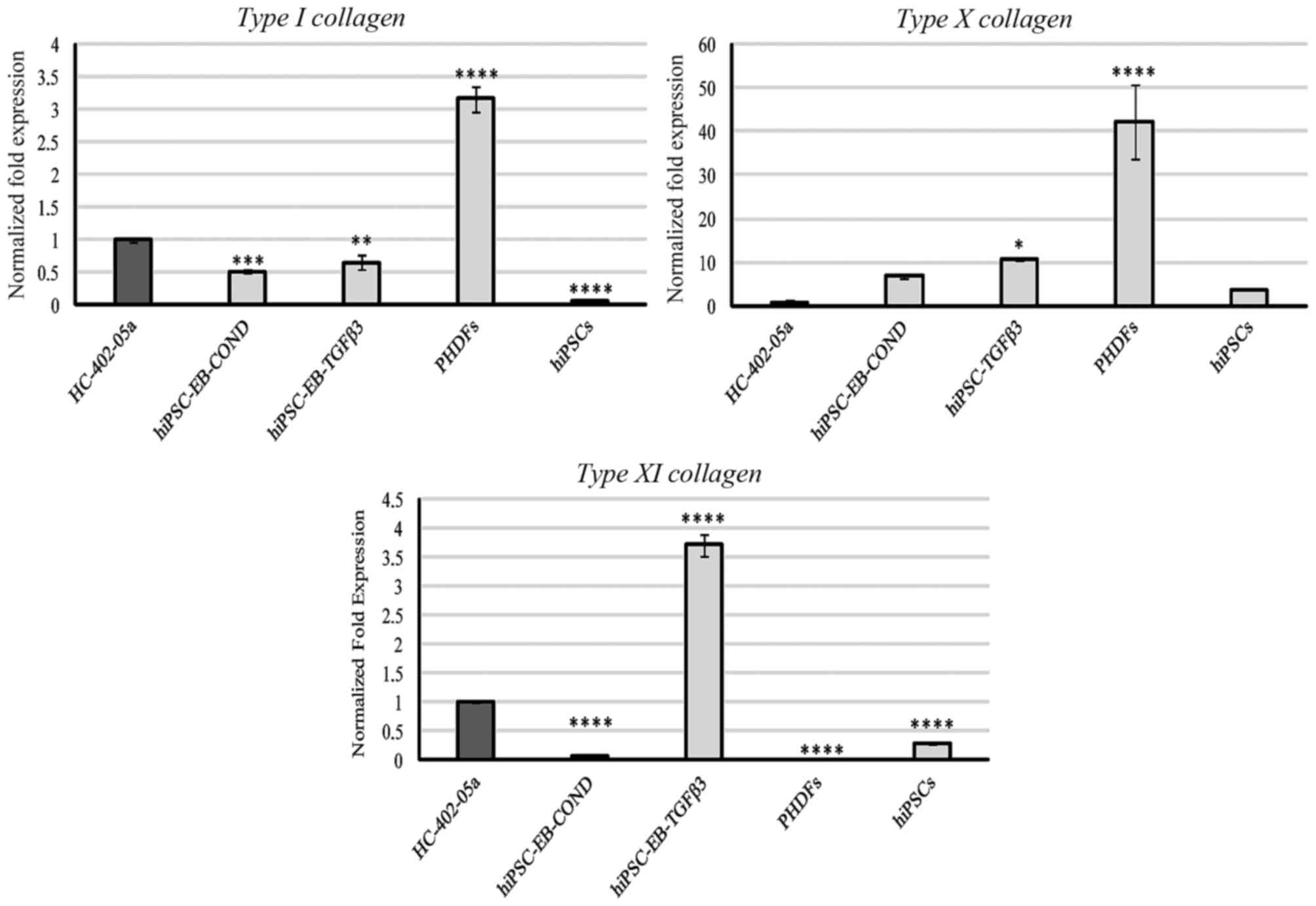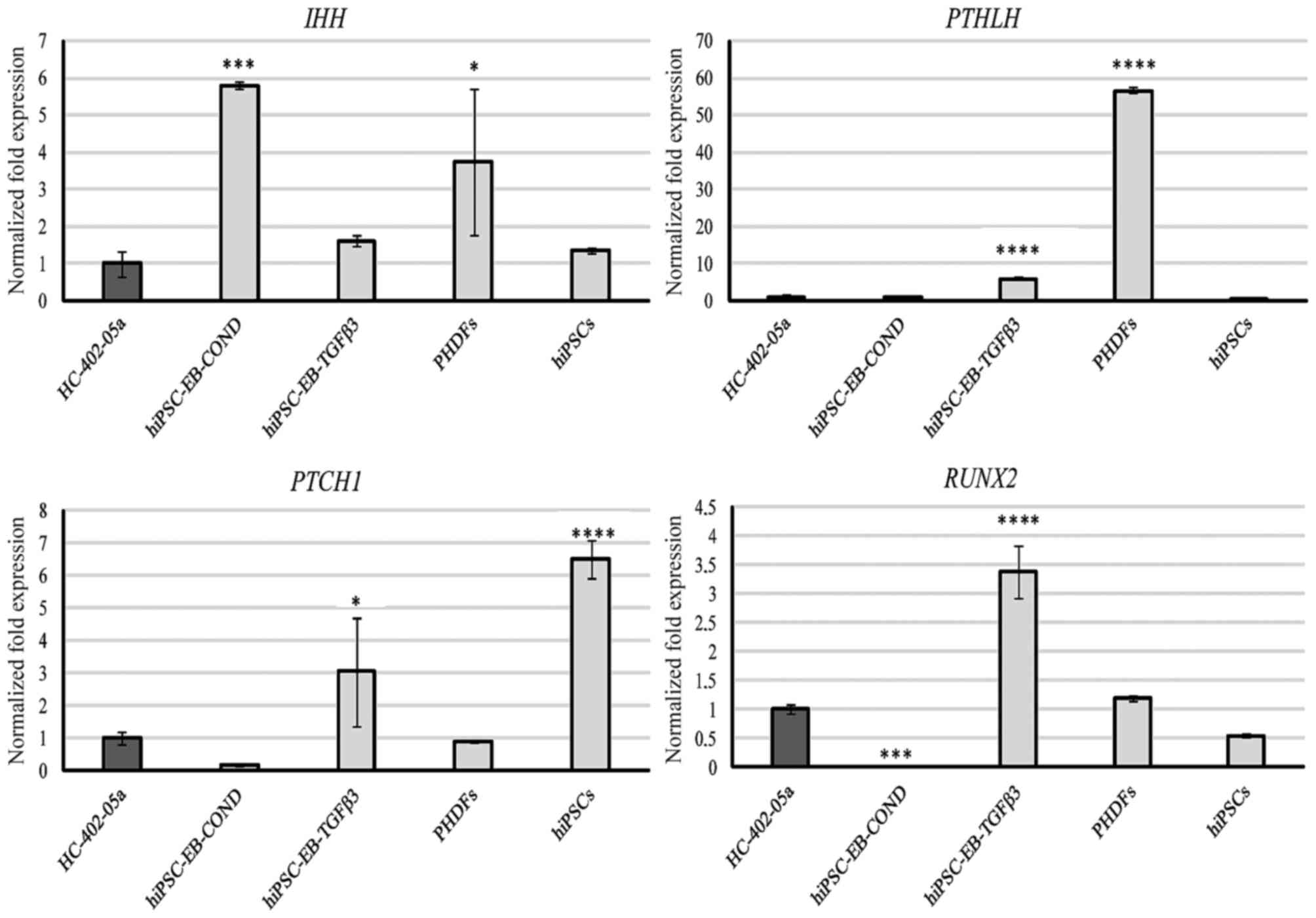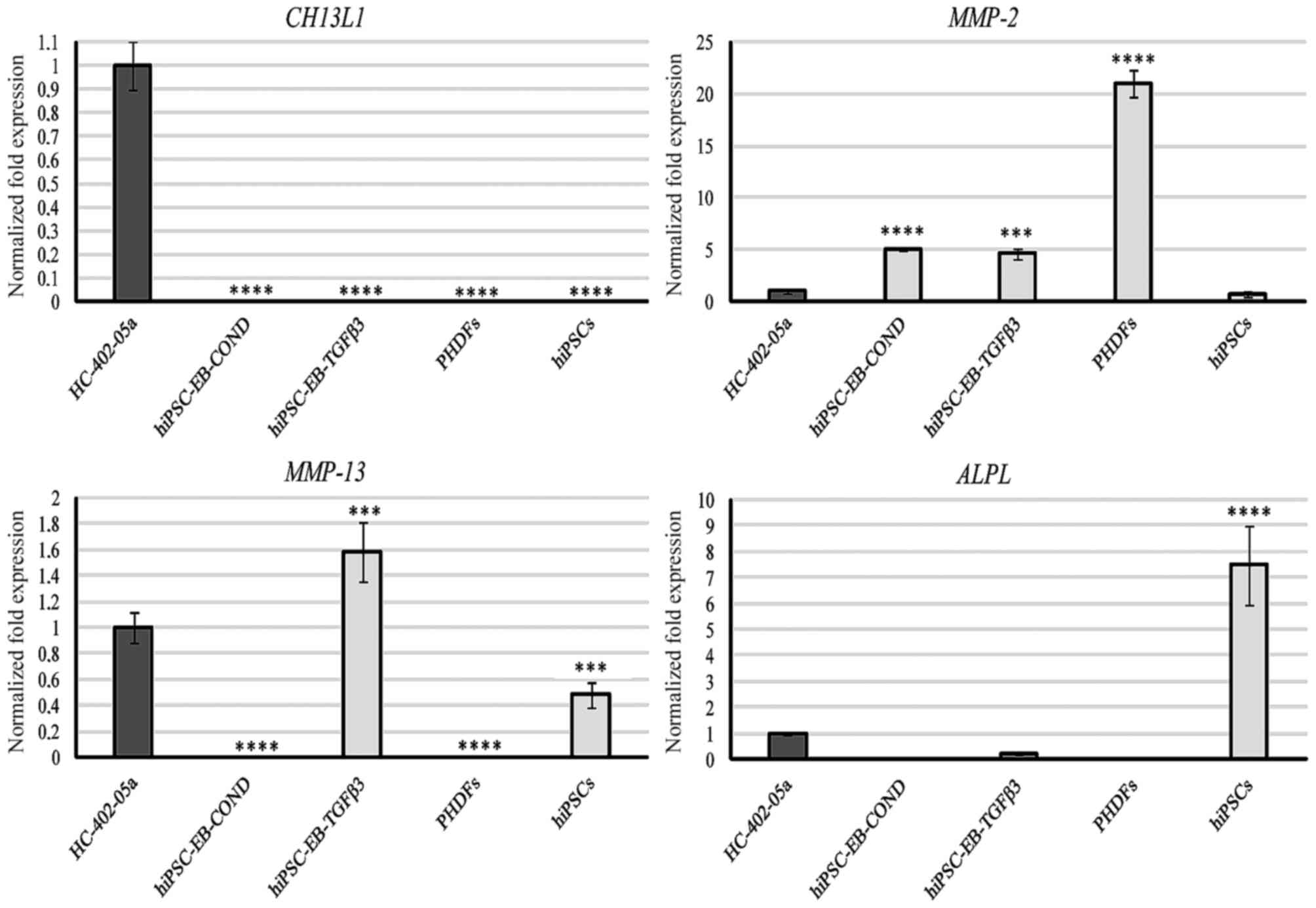|
1
|
Xie A, Nie L, Shen G, Cui Z, Xu P, Ge H
and Tan Q: The application of autologous platelet-rich plasma gel
in cartilage regeneration. Mol Med Rep. 10:1642–1648.
2014.PubMed/NCBI
|
|
2
|
Saito T, Yano F, Mori D, Kawata M, Hoshi
K, Takato T, Masaki H, Otsu M, Eto K, Nakauchi H, et al: Hyaline
cartilage formation and tumorigenesis of implanted tissues derived
from human induced pluripotent stem cells. Biomed Res. 36:179–186.
2015. View Article : Google Scholar : PubMed/NCBI
|
|
3
|
Tang J, Cui W, Song F, Zhai C, Hu H, Zuo Q
and Fan W: Effects of mesenchymal stem cell on
interleukin-1β-treated chondrocytes and cartilage in a rat
osteoarthritic model. Mol Med Rep. 12:1753–1760. 2015.PubMed/NCBI
|
|
4
|
Suchorska WM, Augustyniak E and Łukjanow
M: Genetic stability of pluripotent stem cells during anti-cancer
therapies. Exp Ther Med. 11:695–702. 2016.PubMed/NCBI
|
|
5
|
Sommer AG, Rozelle SS, Sullivan S, Mills
JA, Park SM, Smith BW, Iyer AM, French DL, Kotton DN, Gadue P, et
al: Generation of human induced pluripotent stem cells from
peripheral blood using the STEMCCA lentiviral vector. J Vis Exp.
2012:43272012.
|
|
6
|
Barczak W, Suchorska W, Rubiś B and
Kulcenty K: Universal real-time PCR-based assay for lentiviral
titration. Mol Biotechnol. 57:195–200. 2015. View Article : Google Scholar : PubMed/NCBI
|
|
7
|
Ye J, Hong J and Ye F: Reprogramming rat
embryonic fibroblasts into induced pluripotent stem cells using
transposon vectors and their chondrogenic differentiation in vitro.
Mol Med Rep. 11:989–994. 2015.PubMed/NCBI
|
|
8
|
Oldershaw RA, Baxter MA, Lowe ET, Bates N,
Grady LM, Soncin F, Brison DR, Hardingham TE and Kimber SJ:
Directed differentiation of human embryonic stem cells toward
chondrocytes. Nat Biotechnol. 28:1187–1194. 2010. View Article : Google Scholar : PubMed/NCBI
|
|
9
|
Phillips MD, Kuznetsov SA, Cherman N, Park
K, Chen KG, McClendon BN, Hamilton RS, McKay RD, Chenoweth JG,
Mallon BS and Robey PG: Directed differentiation of human induced
pluripotent stem cells toward bone and cartilage: In vitro versus
in vivo assays. Stem Cell Transl Med. 3:867–878. 2014. View Article : Google Scholar
|
|
10
|
Toh WS and Cao T: Derivation of
chondrogenic cells from human embryonic stem cells for cartilage
tissue engineering. Methods Mol Biol. Jul 12–2014.(Epub ahead of
print). View Article : Google Scholar : PubMed/NCBI
|
|
11
|
Mardani M, Hashemibeni B, Ansar MM,
Esfahani Zarkesh SH, Kazemi M, Goharian V, Esmaeili N and
Esfandiary E: Comparison between chondrogenic markers of
differentiated chondrocytes from adipose deived stem cells and
articular chondrocytes in vitro. Iran J Basic Med Sci. 16:763–773.
2013.PubMed/NCBI
|
|
12
|
Lee HJ, Choi BH, Min BH and Park SR:
Changes in Surface markers of human mesenchymal stem cells during
the chondrogenic differentiation and dedifferentiation processes in
vitro. Arthritis Rheum. 60:2325–2332. 2009. View Article : Google Scholar : PubMed/NCBI
|
|
13
|
Trzeciak T, Augustyniak E, Richter M,
Kaczmarczyk J and Suchorska W: Induced pluripotent and mesenchymal
stem cells as a promising tool for articular cartilage
regeneration. J Cell Sci Ther. 5:42014. View Article : Google Scholar
|
|
14
|
Suchorska WM, Augustyniak E, Richter M and
Trzeciak T: Gene expression profile in human induced pluripotent
stem cells: Chondrogenic differentiation in vitro-part A.
Mol Med Rep. 15:2387–2401. 2017.
|
|
15
|
Wróblewska J: A new method to generate
human induced pluripotent stem cells (iPS) and the role of the
protein KAP1 in epigenetic regulation of self-renewal. PhD
dissertation. Poznan University of Medical Sciences. http://www.wbc.poznan.pl/Content/373798/index.pdf2015.
|
|
16
|
Suchorska WM, Lach MS, Richter M,
Kaczmarczyk J and Trzeciak T: Bioimaging: An useful tool to monitor
differentiation of human embryonic stem cells into chondrocytes.
Ann Biomed Eng. 44:1845–1859. 2016. View Article : Google Scholar : PubMed/NCBI
|
|
17
|
Nejadnik H, Diecke S, Lenkov OD, Chapelin
F, Doing J, Tong X, Derugin N, Chan RC, Gaur A, Yang F, et al:
Improved approach for chondrogenic differentiation of human induced
pluripotent stem cells. Stem Cell Rev. 11:242–253. 2015. View Article : Google Scholar : PubMed/NCBI
|
|
18
|
Livak KJ and Schmittgen TD: Analysis of
relative gene expression data using real-time quantitative PCR and
the 2(−Delta Delta C (T)) Method. Methods. 25:402–408. 2001.
View Article : Google Scholar : PubMed/NCBI
|
|
19
|
Polacek M, Bruun JA, Johansen O and
Martinez I: Comparative analyses of the secretome from
dedifferentiated and redifferentiated adult articular chondrocytes.
Cartilage. 2:186–196. 2011. View Article : Google Scholar : PubMed/NCBI
|
|
20
|
Meng W, Xia Q, Wu L, Chen S, He X, Zhang
L, Gao Q and Zhou H: Downregulation of TGF-beta receptors types II
and III in squamous cell carcinoma and oral carcinoma-associated
fibroblasts. BMC Cancer. 11:882011. View Article : Google Scholar : PubMed/NCBI
|
|
21
|
Derynck R and Zhang YE: Smad-dependent and
Smad-independent pathways in TGF-beta family signaling. Nature.
425:577–584. 2003. View Article : Google Scholar : PubMed/NCBI
|
|
22
|
Keller B, Yang T, Chen Y, Munivez E,
Bertin T, Zabel B and Lee B: Interaction of TGFβ and BMP signaling
pathways during chondrogenesis. PLoS One. 6:e164212011. View Article : Google Scholar : PubMed/NCBI
|
|
23
|
Shen B, Wei A, Tao H, Diwan AD and Ma DD:
BMP-2 enhances TGF-beta3-mediated chondrogenic differentiation of
human bone marrow multipotent mesenchymal stromal cells in alginate
bead culture. Tissue Eng Part A. 15:1311–1320. 2009. View Article : Google Scholar : PubMed/NCBI
|
|
24
|
Chen G, Deng C and Li YP: TGF-β and BMP
signaling in osteoblast differentiation and bone formation. Int J
Biol Sci. 8:272–288. 2012. View Article : Google Scholar : PubMed/NCBI
|
|
25
|
Huang F and Chen YG: Regulation of TGF-β
receptor activity. Cell Biosci. 2:92012. View Article : Google Scholar : PubMed/NCBI
|
|
26
|
Shen J, Li S and Chen D: TGF-β signaling
and the development of osteoarthritis. Bone Res. 2:140022014.
View Article : Google Scholar : PubMed/NCBI
|
|
27
|
Watabe T and Miyazono K: Roles of TGF-beta
family signaling in stem cell renewal and differentiation. Cell
Res. 19:103–115. 2009. View Article : Google Scholar : PubMed/NCBI
|
|
28
|
Wang W, Rigueur D and Lyons KM: TGFβ
signaling in cartilage development and maintenance. Birth Defects
Res C Embryo Today. 102:37–51. 2014. View Article : Google Scholar : PubMed/NCBI
|
|
29
|
Tan F, Quian C, Tanq K, Abd-Allach SM and
Jing N: Inhibition of transforming growth factor β (TGF-β)
signaling can substitute for Oct4 protein in reprogramming and
maintain pluripotency. J Biol Chem. 290:4500–4511. 2015. View Article : Google Scholar : PubMed/NCBI
|
|
30
|
Davidson Blaney EN, Vitters EL, van den
Berg WB and van der Kraan PM: TGF beta-induced cartilage repair is
maintained but fibrosis is blocked in the presence of Smad7.
Arthritis Res Ther. 8:R652006. View
Article : Google Scholar : PubMed/NCBI
|
|
31
|
Tekari A, Luginbuehl R, Hofstetter W and
Egli RJ: Transforming growth factor beta signaling is essential for
the autonomous formation of cartilage-like tissue by expanded
chondrocytes. PLoS One. 10:e01208572015. View Article : Google Scholar : PubMed/NCBI
|
|
32
|
Li F and Niyibizi C: Cells derived from
murine induced pluripotent stem cells (iPSC) by treatment with
members of TGF-beta family give rise to osteoblasts differentiation
and form bone in vivo. BMC Cell Biol. 13:352012. View Article : Google Scholar : PubMed/NCBI
|
|
33
|
Sun J, Li J, Li C and Yu Y: Role of bone
morphogenetic protein-2 in osteogenic differentiation of
mesenchymal stem cells. Mol Med Rep. 12:4230–4237. 2015.PubMed/NCBI
|
|
34
|
Shu B, Zhang M, Xie R, Wang M, Jin H, Hou
W, Tang D, Harris SE, Mishina Y, O'Keefe RJ, et al: BMP-2, but not
BMP-4, is crucial for chondrocyte proliferation and maturation
during endochondral bone development. J Cell Sci. 124:3428–3440.
2011. View Article : Google Scholar : PubMed/NCBI
|
|
35
|
Matsubara T, Kida K, Yamaguchi A, Hata K,
Ichida F, Meguro H, Aburatani H, Nishimura R and Yoneda T: Bmp2
regulates Osterix through Msx2 and Runx2 during osteoblast
differentiation. J Biol Chem. 283:29119–29125. 2008. View Article : Google Scholar : PubMed/NCBI
|
|
36
|
Sun Z, Zhang Y, Yang S, Jia J, Ye S, Chen
D and Mo F: Growth differentiation factor 5 modulation of
chondrogenesis of self-assembled constructs involves gap
junction-mediated intercellular communication. Dev Growth Differ.
54:809–817. 2012. View Article : Google Scholar : PubMed/NCBI
|
|
37
|
Coleman CM, Vaughan EE, Browe DC, Mooney
E, Howard L and Barry F: Growth differentiation factor-5 enhances
in vitro mesenchymal stromal cell chondrogenesis and hypertrophy.
Stem Cells Dev. 22:1968–1976. 2013. View Article : Google Scholar : PubMed/NCBI
|
|
38
|
Hatakeyama Y, Hatakeyama J, Maruya Y, Oka
K, Tsuruga E, Inai T and Sawa Y: Growth differentiation factor 5
(GDF-5) induces matrix metalloproteinase 2 (MMP-2) expression in
peridontal ligament cells and modulates MMP-2 and MMP-13 activity
in osteoblasts. Bone and Tissue Regeneration Insights. 3:1–10.
2010.
|
|
39
|
Furumatsu T, Tsuda M, Taniguchi N, Tajima
Y and Asahara H: Smad3 induces chondrogenesis through the
activation of SOX9 via CREB-binding protein/p300 recruitment. J
Biol Chem. 280:8343–8350. 2005. View Article : Google Scholar : PubMed/NCBI
|
|
40
|
Zhang M, Wang M, Tan X, Li TF, Zhang YE
and Chen D: Smad3 prevents beta-catenin degradation and facilitates
beta-catenin nuclear translocation in chondrocytes. J Biol Chem.
285:8703–8710. 2010. View Article : Google Scholar : PubMed/NCBI
|
|
41
|
Chen CG, Thuillier D, Chin EN and Alliston
T: Chondrocyte-intrinsic Smad3 represses Runx2-inducible matrix
metalloproteinase 13 expression to maintain articular cartilage and
prevent osteoarthritis. Arthritis Rheum. 64:3278–3289. 2012.
View Article : Google Scholar : PubMed/NCBI
|
|
42
|
Savontaus M, Ihanamäki T, Perälä M,
Metsäranta M, Sandberg-Lall M and Vuorio E: Expression of type II
and IX collagen isoforms during normal and pathological cartilage
and eye development. Histochem Cell Biol. 110:149–159. 1998.
View Article : Google Scholar : PubMed/NCBI
|
|
43
|
Krug D, Klinger M, Haller R, Hargus G,
Büning J, Rohwedel J and Kramer J: Minor cartilage collagens type
IX and XI are expressed during embryonic stem-cell derived in vitro
chondrogenesis. Ann Ant. 195:88–97. 2013. View Article : Google Scholar
|
|
44
|
Goessler UR, Bugert P, Bieback K, Baisch
A, Sadick H, Verse T, Klüter H, Hörmann K and Riedel F: Expression
of collagen fiber-associated proteins in human septal cartilage
during in vitro dedifferentiation. Int J Mol Med.
14:1015–1022. 2004.PubMed/NCBI
|
|
45
|
Mwale F, Stachura D, Roughley P and
Antoniou J: Limitations of using aggrecan and type X collagen as
markers of chondrogenesis in mesenchymal stem cell differentiation.
J Orthop Res. 24:1791–1798. 2006. View Article : Google Scholar : PubMed/NCBI
|
|
46
|
McAlinden A, Traeger G, Hansen U, Weis MA,
Ravindran S, Wirthlin L, Eyre DR and Fernandes RJ: Molecular
properties and fibril ultrastructure of type II and XI collagens in
cartilage of mice expressing exclusively the α1 (IIA) collagen
isoform. Matrix Biol. 34:105–113. 2014. View Article : Google Scholar : PubMed/NCBI
|
|
47
|
Ma RS, Zhou ZL, Luo JW, Zhang H and Hou
JF: The Ihh signal is essential for regulating proliferation and
hypertrophy of cultured chicken chondrocytes. Comp Biochem Physiol
B Biochem Mol Biol. 166:117–122. 2013. View Article : Google Scholar : PubMed/NCBI
|
|
48
|
Katoh Y and Katoh M: Hedgehog signaling
pathway and gastrointestinal stem cell signaling network (Review).
Int J Mol Med. 18:1019–1023. 2006.PubMed/NCBI
|
|
49
|
Mak KK, Konenberg HM, Chuang PT, Mackem S
and Yang Y: Indian hedgehog signals independently of PTHrP to
promote chondrocyte hypertrophy. Development. 135:1947–1956. 2008.
View Article : Google Scholar : PubMed/NCBI
|
|
50
|
Später D, Hill TP, O'sullivan RJ, Gruber
M, Conner DA and Hartmann C: Wnt9asignaling is required for joint
integrity and regulation of Ihh during chondrogenesis. Development.
133:3039–3049. 2006. View Article : Google Scholar : PubMed/NCBI
|
|
51
|
Wang Y, Cheng Z, Elalieh HZ, Nakamura E,
Nguyen MT, Mackem S, Clemens TL, Bikle DD and Chang W: IGF-1R
signaling in chondrocytes modulates growth plate development by
interacting with the PTHrP/Ihh pathway. J Bone Miner Res.
26:1437–1446. 2011. View Article : Google Scholar : PubMed/NCBI
|
|
52
|
Kim EJ, Cho SW, Shin JO, Lee MJ, Kim KS
and Jung HS: Ihh and Runx2/Runx3 signaling interact to coordinate
early chondrogenesis: A mouse model. PLoS One. 8:e552962013.
View Article : Google Scholar : PubMed/NCBI
|
|
53
|
Tu X, Joeng KS and Long F: Indian hedgehog
requires additional factors besides Runx2 to induces osteoblast
differentiation. Dev Biol. 362:76–82. 2012. View Article : Google Scholar : PubMed/NCBI
|
|
54
|
Liu Z, Xu J, Colvin JS and Ornitz DM:
Coordination of chondrogenesis and osteogenesis by fibroblast
growth factor 18. Genes Dev. 16:859–869. 2002. View Article : Google Scholar : PubMed/NCBI
|
|
55
|
Bruce SJ, Butterfield NC, Metzis V, Town
L, McGlinn E and Wicking C: Inactivation of Patched 1 in the mouse
limb has novel inhibitory effects on the chondrogenic program. J
Biol Chem. 285:27967–27981. 2010. View Article : Google Scholar : PubMed/NCBI
|
|
56
|
Moon JH, Heo JS, Kim JS, Jun EK, Lee JH,
Kim A, Kim J, Whang KY, Kang YK, Yeo S, et al: Reprogramming
fibroblasts into induced pluripotent stem cells with Bmi1. Cell
Res. 21:1305–1315. 2011. View Article : Google Scholar : PubMed/NCBI
|
|
57
|
Vimalraj S, Arumugam B, Miranda PJ and
Selvamurugan N: Runx2: Structure, function, and phosphorylation in
osteoblast differentiation. Int J Biol Macromol. 78:202–208. 2015.
View Article : Google Scholar : PubMed/NCBI
|
|
58
|
Sun J, Zhou H, Deng Y, Zhang Y, Gu P, Ge S
and Fan X: Conditioned medium from bone marrow mesenchymal stem
cells transiently retards osteoblast differentiation by
downregulating runx2. Cells Tissues Organs. 196:510–522. 2012.
View Article : Google Scholar : PubMed/NCBI
|
|
59
|
Ann EJ, Kim HY, Choi YH, Kim MY, Mo JS,
Jung J, Yoon JH, Kim SM, Moon JS, Seo MS, et al: Inhibition of
Notch1 signaling by Runx2 during osteoblast differentiation. J Bone
Miner Res. 26:317–330. 2011. View Article : Google Scholar : PubMed/NCBI
|
|
60
|
Komori T: Regulation of bone development
and extracellular matrix protein genes by RUNX2. Cell Tissue Res.
339:189–195. 2010. View Article : Google Scholar : PubMed/NCBI
|
|
61
|
Du F, Wu H, Zhou Z and Liu YU:
microRNA-375 inhibits osteogenic differentiation by targeting
runt-related transcription factor 2. Exp Ther Med. 10:207–212.
2015.PubMed/NCBI
|



